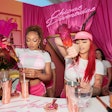
Melissa Park is a global event producer and founder of Melissa Park Events, specializing in elevating brands and amplifying corporate messages.
When planning a conference, I like to coordinate each night's activity to a different segment of the audience. Rather than feeling obligated to go to everything in the program from breakfast until bed, this enables attendees to engage with the planned content during the day and attend only those events that are relevant to them at night.
Attendees who can take time out of the scheduled events to catch up on emails, meet deadlines, have a private dinner with industry colleagues or simply take a night off to reflect and relax will be the most engaged during the day when your key content is delivered.
Here are what I’ve found to be the essential elements you should include in each nightly event to guarantee they’re a massive success, as well as the creative measures you can take to ensure you’re delivering them with COVID-19 precautions in place.
 Melissa ParkPhoto: Heist Creative
Melissa ParkPhoto: Heist Creative
Night Zero is for the First-Timers
The evening before your conference program officially kicks off is the perfect time to host ice-breaker events for first-time attendees. These events are a soft introduction into the conference that offers newbies an opportunity to network with like-minded people who want to ease into the conference, and if they’re attending on their own, possibly even make a new friend.
This can look like:
Meetups: Focused on a specific topic or relevant area of interest, attendees come together to listen to a short presentation and then discuss the topic in a casual networking environment. While there is rarely a theme or entertainment, food and beverage ranging from pizza, beer and sundaes to cocktails and canapes should be served to encourage people to stay and continue the conversation after the organized presentation ends.
To keep the menu COVID-friendly, consider serving boxed personal pizzas, individually prepackaged canapes (with utensils and condiments included), single-serve treats like wrapped ice creams or mini tubs, and bottled beverages or specialty cocktails made and served to order to avoid having them sitting in the open air for an extended period.
First-Timer Function: The sole purpose of this style of event is to provide a place to meet other attendees. While they can be awkward at the beginning, team-building-style activities are a great inclusion in this format as it forces people to engage without the pressure of having to approach a stranger.
Pre-COVID, I would have recommended something interactive, like having the venue’s head chef lead a cooking class during which guests make their own appetizers, or bar staff to design the conference’s signature cocktail. While this can still be done, given people have different levels of comfort surrounding interaction, I would adapt the activity to have each individual make their own meal or beverage. This modified delivery will still be a lot of fun, barriers will still be broken down and interaction will still be had from the safety of each attendee’s individual bar or cooking station.
Opening Reception: If your event has an exhibition component, this is the perfect time for an opening reception. Lasting just an hour or two, this type of standup cocktail event sets the tone for the day(s) ahead, so be sure you do not scrimp on your F&B.
Stocked bars with bottled beverages (prepoured glasses should no longer be an option), food stations serving individually portioned packaged meals (with utensils and condiments included), roving entertainment, an upbeat playlist, dedicated time to talk with sponsors before they’re competing with education sessions, and short meal breaks can make this a sure-fire success. One added bonus is that you’ll also check-in a large majority of your attendees, which will result in fewer long lines for those checking in on Day 1.
Night 1 is for the Executives
Night one is an opportune time for executive or VIP dinners since most who would qualify for this cannot take multiple days out of the office and will instead attend a conference’s opening keynote and then line up meetings for the rest of the day to continue business.
One of my favorite phrases is, “Do it well or don’t do it at all,” and this rings especially true when it comes to C-suite events. Prior to planning, think about your audience and how many dinners/events they attend. You’ve got to make it special.
Here’s how I do it:
Executive or VIP Dinners: Exclusive experiences, customized menus served with fine wine, whiskey or craft cocktail pairings, highly sought-after locations or destinations, a wow-factor entertainer or special guest, and to-die-for theming are just a few of the ways you can impress.
Save the interactive activities for another group. Unless it’s a round of golf at Pebble Beach, this group isn’t going to be interested.
Night 2 is for the General Admission Folks
Everyone has just finished two days of great content that has engaged, stimulated and educated them. Now they want some social time, and maybe even some recognition for work they’ve done.
Here’s how that looks:
Gala/Awards Dinner: If a formal dinner is part of your program, make it fun! An immersive entrance into your cocktail space, a room reveal (if your theming calls for it), engaging entertainment both on and off stage, a top-notch emcee to keep the night flowing, lounge areas with photo opportunities (if there's time for mixing, mingling and dancing later in the night), and arguably the most important of all, a melt-in-your-mouth menu.
Work with your chef to create a culinary experience that will knock your guests’ socks off. I love serving each course in a different way. For example: a tasting plate appetizer, Brazilian steakhouse-style main and an interactive dessert service like a live-action station for anything that can be customized or needs to be served warm. This will double as an event feature that easily adds a wow-factor to your event.
How can you make this COVID-friendly? That’s simple.
For family-style courses, modify service to a Brazilian barbecue-style delivery. Rather than having platters of each menu option placed on the table, have your waitstaff roam with said platters and personally serve attendees the items they’d like to enjoy. Given they’ll be masked and protected, this service modification still provides an interactive element but removes the risks associated with the passing of platters around a table.
When it comes to your dessert, provide attendees with an individual mini-platter featuring each of the optional toppings and then have wait staff personally serve the main item off a cart. These small service modifications enable you to achieve the exact same experience that would have been enjoyed in a prepandemic setting.
Be sure to consider common special dietary restrictions (SDR) when creating your menu and try to cater to them as part of your standard offering. Tasting plates and family-style delivery—no matter whether it’s served traditionally or Brazilian barbecue-style—actually make the management of SDRs easier with each dish being plated individually with no chance of cross-contamination so you can offer complete dishes that are vegan, vegetarian, gluten and/or dairy free.
Conference Party: After being in back-to-back sessions for two days, your attendees will be ready to let loose and have fun, so make it easy by including an amazing headline act who can quickly get a crowd on their feet. Support the band with roving entertainment and flash mob-style performers to surprise and delight. While somewhat immersive in terms of it being pop-up and all-surrounding, this style of entertainment is typically performed at a distance and can therefore be considered “COVID-safe.”
If your venue allows, theme each room or floor differently and include Instagrammable activations, interactive activities and photo opportunities to complement each space.
When it comes to catering, prepackaged food stations (served with utensils and condiments included) enable the menu to be spread throughout a space more effectively than a traditional buffet, and dishes to be served in many different ways. Stations can still be interactive but rather than have everyone select toppings and serve themselves from communal tubs, adopt a more casual approach to the dessert idea I suggested for the gala dinner.
Stack all options into grab-n-go mini containers that attendees can use to dress their meal once they’re back in their seat (bonus: this will still do the trick and reduce lines). Signature cocktails are always a delicious addition, but be sure they remain on theme!
Now let’s talk about timing for each of these events.
The biggest mistake I see organizers make is programming the party to last three or more hours. You always want to leave attendees wanting more, so end the party before it thins out. Keep it to two hours, and you’ll be golden!
For both of these Night 2 events, I recommend hiring a venue that allows everything to be spread out more than you would have designed in the past. While you don’t want it to feel sparse, having a little white space to freely move around will make your attendees more comfortable mixing and mingling with a room full of strangers.
Additionally, providing on-theme, “COVID-safe” PPE can help attendees get in the spirit and reduce resistance to being asked to wear a mask. It goes without saying, but regular deep-cleaning of all surfaces with hospital-grade cleaner and ensuring there are ample sanitizing stations around the site are musts.
Since it’s a little trickier to track attendance and enforce COVID measures at large-scale, casual events, conduct temperature checks upon arrival and ask everyone to check-in via a QR code prior to gaining entry. This will mitigate risk up front, then you can employ fun and friendly COVID Marshals to be strategically placed throughout the site to promote and take practical steps to ensure all individuals are complying with the COVID practices.
Night 3 is for No One!
Even if the third day of your event ends later in the afternoon, most of your guests will depart as soon as the educational component comes to a close, so I don’t recommend scheduling anything afterward. Reallocate whatever budget you had thought for that night to one of the earlier evenings to enhance those experiences when your guests are most engaged.
Given what the industry has just endured, I don’t believe you can be “too safe.” You just have to design a user-friendly process to deliver all of your requirements as conveniently, speedily and seamlessly as possible.
And don’t forget: Communication is key! Send all registered attendees an email prior to your event outlining all policies and asking that anyone experiencing COVID-19 symptoms to cancel their plans to attend the event.



















